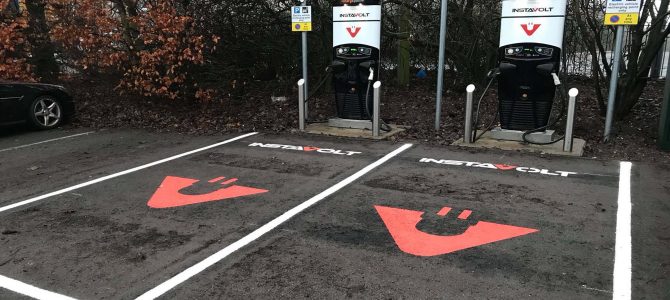As we move from a time when EV charging points are invariably accessible to anyone who needs them to a more congested and complex world of EVs everywhere – yes I was one of those people who used to point out every EV I saw on the road, I now only point out the ones I haven’t seen before – it is going to be more important to have a robust etiquette that everyone subscribes to.
This will be even more important than ever as charging points become more mainstream on streets in and around crowded cities. So, what should we consider about the etiquette that hasn’t already been highlighted? Well let’s recap first on what we already have in place:
- Leave the space only for EV charging
- Be polite and courteous to others –
a. Write polite notes
b. Don’t rant at those ICE-ing (parking internal combustion engine vehicles on EV parking bays), be polite while pointing out the errors of their ways – after all how many of these spots do they see in use at the moment
c. Help others that are having difficulty with the charger – but first ask if they need help - If you can, swap over the charging cable to the next EV when yours is finished and they are waiting – not so easy now it is mostly a paid for service
- Don’t ‘hog’ the charging stop – they are often in very advantageous places
- Keep the cables and charge point areas tidy
- Don’t think the all-electric BEV driver has priority over the PHEV owner to charge – some do advocate this
- Report stations that are off-line or damaged.
All of this sound advice still stands, however, more and more as we carry out consultancy projects involving EV charging CWP is being asked to consider the etiquette aspects of EV charging.
It is understandable that in areas where parking space is at a premium, such as city centre and suburban residential areas, parking is already an issue. This will only be exacerbated with dedicated EV on-street parking and street furniture with built in EV facilities. What is more we have a long time to wait until electric vehicles can move themselves around autonomously to charge and park before coming to meet us at the front door. Imagine, your AI vehicle coming to get you when it thinks you should leave – out in those PJs again changing in the car because ‘Autumn’ as ‘she’ is affectionately called keeps peeping the horn connected in your brain because she knows the traffic is worse on that really bad stretch of road today than it has been all week!
It is therefore important that while developing the infrastructure at a rapid pace, we also consider the potentially more thorny question of the etiquette needed to make it all run smoothly. We are rapidly overcoming the barriers to uptake of EVs – price, range anxiety, infrastructure, choice and performance, but will the next hurdle be peoples’ adopted behaviours?
Having spent many hours considering options for charging infrastructure and the rapidly changing range of vehicles, I believe it is time to seriously consider how we establish the network of chargers and their use. It is obvious that if you live in a block of flats having enough charging infrastructure for every apartment/flat is not practical or logical, or having wires running across pavements is not an acceptable option, however, there are plenty of opportunities if we work collaboratively, that will benefit the whole of society. If for instance, there are parking facilities that are vacant during the day and they are near places where others work, can we not establish mechanisms and etiquette that allows others to use those chargers? Or change the way that we think about charging as a personal right?
Yes, I have a charger at home, but I don’t need to use it every day as is suggested by many commentators – definitely some will, if they want to get to work and back each day, but many of us won’t.
For those charging on street or at another place from where the car is left for long periods, then consideration will need to be built into how we swap cars about. If on-street parking is an issue and space is a premium, yet you have managed to squeeze into that space, are you going to give it up even if someone needs to charge up? Perhaps in the future there will be more car sharing and car club services, especially in densely populated areas. However, human nature suggests we will all still want our own vehicle and the convenience it will bring especially, if as has been suggested, EVs will be cheaper than ICE cars. And there will be a whole new etiquette to be learnt when sharing an EV.
I am also not convinced that the idea of charging overnight will remain at cheap rate charging, if we all follow the government’s advice to do this. If the utilities and government have their way, we will all be on smart meters (but remember they are an opt-in ) and at that point, charge rates can be established against ‘time of use’ tariffs, which, while being fixed at set times at present, may end up being based on capacity factors and load on the grid rates – i.e. variable.
If the rates are ‘time of use’ and the use is higher at night due to all the cars on the grid, then people will undoubtedly want to charge at cheaper times if they can – that’s human nature! But, I here you say, what about Vehicle to Grid (V2G) and Vehicle to Building (V2B), that will change the dynamic, surely. Well, only if the benefits outweigh the perceived and actual loss of benefit and amenity. What I mean by that is, if I think I might go out or even could go out and the ‘value added’ to me is too low, then why would I restrict myself by selling back the electricity to the grid?
I was reminded recently by Jonathan Porterfield who runs a very respected second-hand EV sales company (www.eco-cars.net) that some people think we need to charge EVs in the same way as ICE vehicles, however, they are different beasts and perhaps doing what we have done for the last 100 years isn’t how we should consider the next 100 years or so.
I also believe, the etiquette of V2G and V2B and how we think of charging will influence the new etiquette as much as the ‘charge point’ etiquette and ‘street etiquette’. The etiquette of the energy providers will also play a fundamental role in how we engage with them.
So, what does the etiquette need to be like? Fundamentally it will probably need to be more considerate to fellow vehicle users, perhaps more relaxed, courteous and understanding of the fact that you can’t always have that space just outside your door or just be able to drive up and instantly charge at a moments notice.
Gideon Richards, CEO, CWP Ltd




